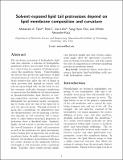Solvent-exposed lipid tail protrusions depend on lipid membrane composition and curvature
Author(s)
Tahir, Mukarram A; Van Lehn, Reid C; Choi, Shinhyun; Alexander-Katz, Alfredo
Downloadprotrusion_main_v2.pdf (5.076Mb)
PUBLISHER_CC
Publisher with Creative Commons License
Creative Commons Attribution
Terms of use
Metadata
Show full item recordAbstract
The stochastic protrusion of hydrophobic lipid tails into solution, a subclass of hydrophobic membrane defects, has recently been shown to be a critical step in a number of biological processes like membrane fusion. Understanding the factors that govern the appearance of lipid tail protrusions is critical for identifying membrane features that affect the rate of fusion or other processes that depend on contact with solvent-exposed lipid tails. In this work, we utilize atomistic molecular dynamics simulations to characterize the likelihood of tail protrusions in phosphotidylcholine lipid bilayers of varying composition, curvature, and hydration. We distinguish two protrusion modes corresponding to atoms near the end of the lipid tail or near the glycerol group. Through potential of mean force calculations, we demonstrate that the thermodynamic cost for inducing a protrusion depends on tail saturation but is insensitive to other bilayer structural properties or hydration above a threshold value. Similarly, highly curved vesicles or micelles increase both the overall frequency of lipid tail protrusions as well as the preference for splay protrusions, both of which play an important role in driving membrane fusion. In multi-component bilayers, however, the incidence of protrusion events does not clearly depend on the mismatch between tail length or tail saturation of the constituent lipids. Together, these results provide significant physical insight into how system components might affect the appearance of protrusions in biological membranes, and help explain the roles of composition or curvature-modifying proteins in membrane fusion.
Date issued
2016-01Department
Massachusetts Institute of Technology. Department of Materials Science and EngineeringJournal
Biochimica et Biophysica Acta (BBA) - Biomembranes
Publisher
Elsevier
Citation
Tahir, Mukarram A., Reid C. Van Lehn, S.H. Choi, and Alfredo Alexander-Katz. “Solvent-Exposed Lipid Tail Protrusions Depend on Lipid Membrane Composition and Curvature.” Biochimica et Biophysica Acta (BBA) - Biomembranes 1858, no. 6 (June 2016): 1207–1215.
Version: Author's final manuscript
ISSN
00052736